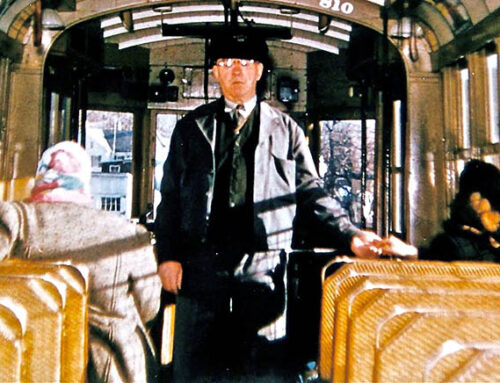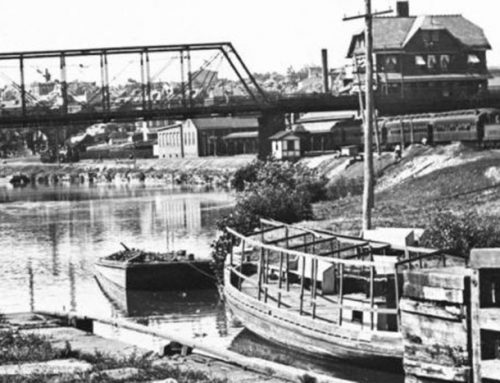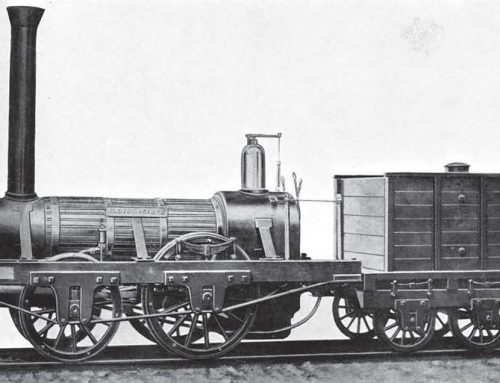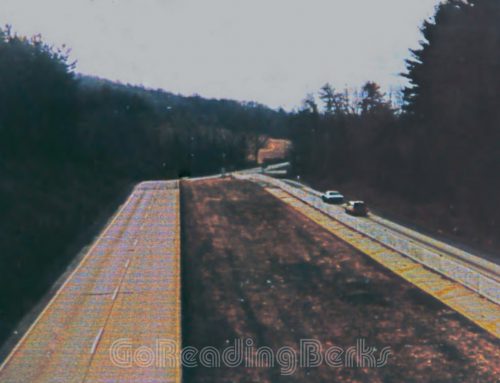On Tuesday afternoon, June 30, 1981, commuters gathered at the Franklin Street Station to board one of the last trains making a run from Pottsville through Reading to Philadelphia waited patiently for the diesel to arrive. The trip would be their last on the passenger rail line operated by Conrail for the Southeastern Pennsylvania Transportation Authority.
Below: All aboard for the final trip of the Reading to Philadelphia run on June 30, 1981.

When the train arrived in Reading, shortly after 3 p.m., the passengers boarded quickly.

Within minutes the train was moving.
Below: Pulling away from the station and heading away from center city on the final trip to Philadelphia.

The conductor walked down the aisle checking tickets.

The train moved into Norristown’s DeKalb station where passengers had to board another train to complete the last leg of the trip to Philadelphia.
As the second train pulled out of the station to continue the trip to the City of Brotherly Love, many of the passengers who had completed the transfer sat quietly in their seats, reflecting on the memories of a train they will see no more.
Below: Passenger seated on the last train ride to Philadelphia from Reading, June 30, 1981.

There were no tears, there were no sighs, only cameras clicking Tuesday evening shortly before 8 o’clock as the final commuter train providing service on the Pottsville-Reading-Norristown line inched slowly into the Franklin Street Station on its last scheduled run.
The train left the Reading Terminal at 12th and Market in Philadelphia at 5:59 p.m. Approximately 70 commuters boarded the two-car train for the journey through the Philadelphia suburbs to Norristown’s DeKalb station where travelers continuing on the line had to debark and board another train headed for Pottstown and finally Reading.
Scheduled arrival time at Reading was 7:40. A small crowd had gathered to greet the train as it eased into the station at 10 mph. At 7:55, cars 9166 and 9167 came into the station and about 25 people descended from the train. At 8:01, spectators gazed at the smoke gray two-car diesel, getting one last glimpse of the empty train before it moved off on its final journey to Conrail’s shops on North Sixth Street.
SEPTA took over the rail service in April 1976 from the bankrupt Reading Co. and authorized Conrail to continue day-to-day passenger operations. At 12:01 a.m., July 1, 1981, Conrail’s contract with the Southeastern Pennsylvania Transportation Authority to operate the commuter service was formally terminated because the authority claimed it was losing an average of $2 million dollars a year. The end of a great era for the city of Reading, made famous by a railroad, had actually come to pass.
Passenger rail service to Reading and its coal-region neighbor Pottsville, was gone. The train had reached the END OF THE LINE!
Below: June 30, 1981 – last scheduled passenger train providing service on the Pottsville-Reading-Norristown line departs Reading’s Franklin Street Station for the Conrail shops along 6th Street in Reading.

Bringing Passenger Trains Back to Reading
In 2020, John P. Weidenhammer, chairman of Berks Alliance, a group of Berks community leaders committed to restoring the train, unveiled the results of a preliminary study, Restoring Passenger Rail Service to Berks County, during a virtual meeting.
The $80,000 study conducted by Transportation Economics & Management Systems Inc., TEMS, based in Frederick, Md., concluded now is the time to bring back the train.
The goal is to have six new trains rolling in 2025.
The cost estimate is $356 million, including purchase of the trains and paying Norfolk Southern for the right-of-way costs for its tracks, and associated upgrades.
The annual cost to operate the train is estimated at $20 million.
The proposal is much less costly than the last proposal from 1999 that was $2 billion because the new plan is for riding existing rails rather than building new tracks.
The train would stop in Reading, Pottstown, Royersford, Phoenixville, and Norristown. Stops could also include Wyomissing and Birdsboro.
From there, it would head to Philadelphia, stopping at Temple University, Jefferson station, Suburban Station and 30th Street station.
At 30th Street station, the train would connect to train service to New York, Baltimore and Washington.
The train would travel at a speed of up to 79 mph.
It would take an hour and 22 minutes to go from Reading to 30th Street station in Philadelphia if the train made all stops. There could be an express train that would reduce the time significantly.
The train would be a reliable, useful way of transportation for students, faculty and families with two new higher education schools opening soon in Berks.
Drexel University College of Medicine at Tower Health in Wyomissing is on track to open in the 2021-22 academic school year. The campus will have the capacity to educate 200 medical students.
The new plan calls for using the Norfolk Southern Railway, which runs freight trains on the track, and SEPTA track at a cost estimate of $356 million.
In comparison, a 1999 study called for building all new tracks and had a price tag of $2 billion.
The new study estimated that if the train is restored, property values would increase $265.9 million in Reading from 2025-54 because of the convenient access to the cities along the Northeast corridor. During the same time period, property taxes in Reading would increase by $240 million, according to the study.
If all goes as expected, a one-way ticket from Reading to Philadelphia could cost as little as $9.





Just in time for my retirement in 2025
Amazing …cant wait for this service to begin we really need thus service for work travel and school